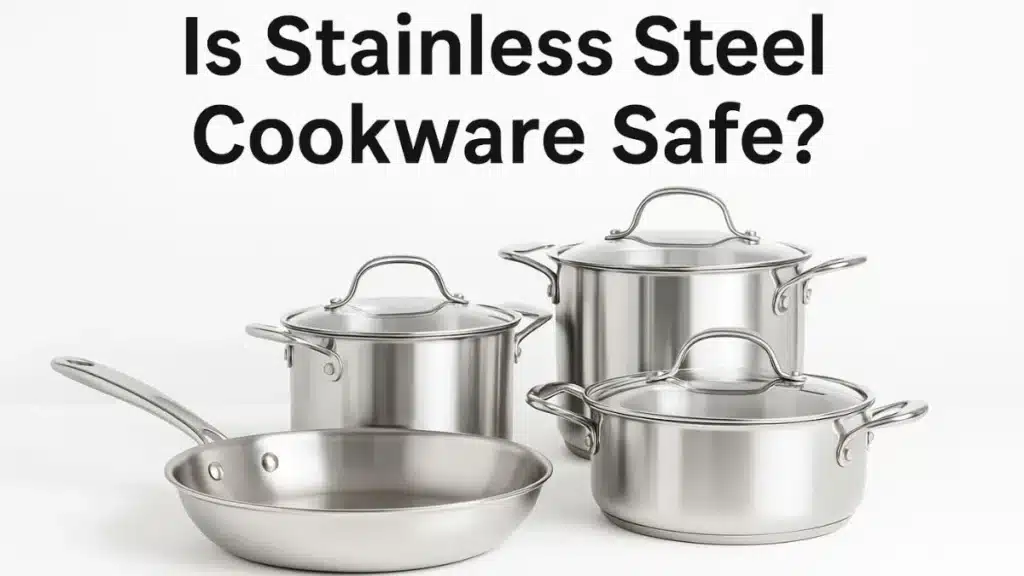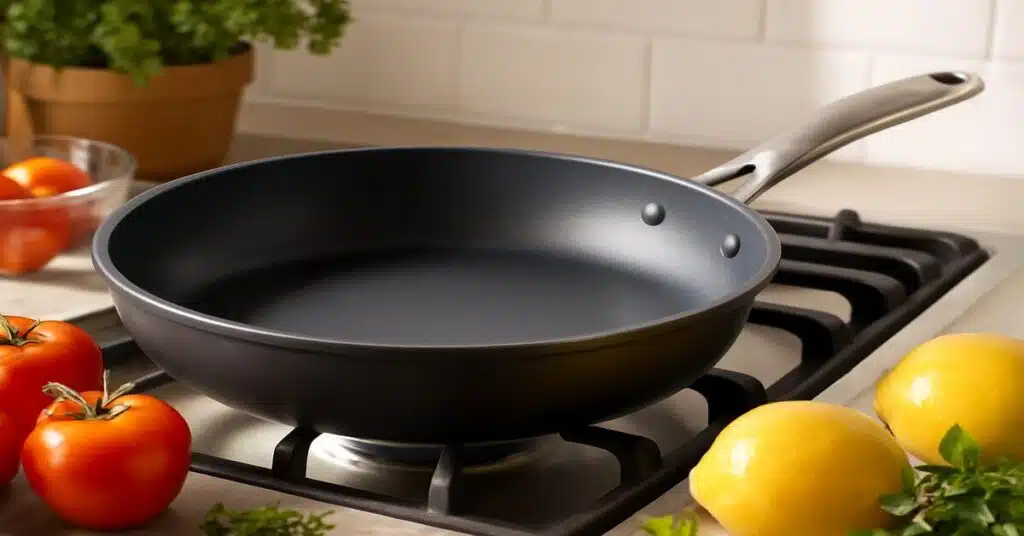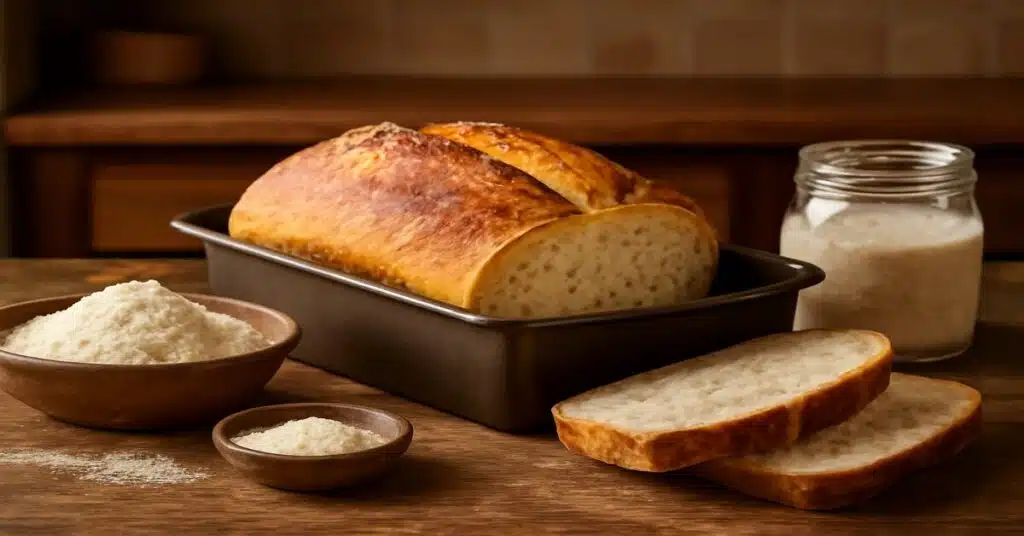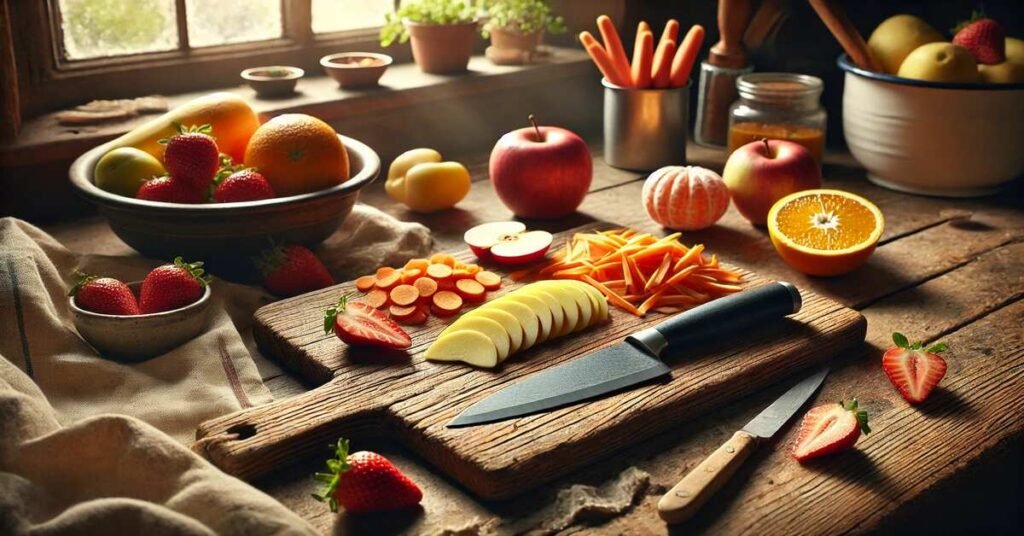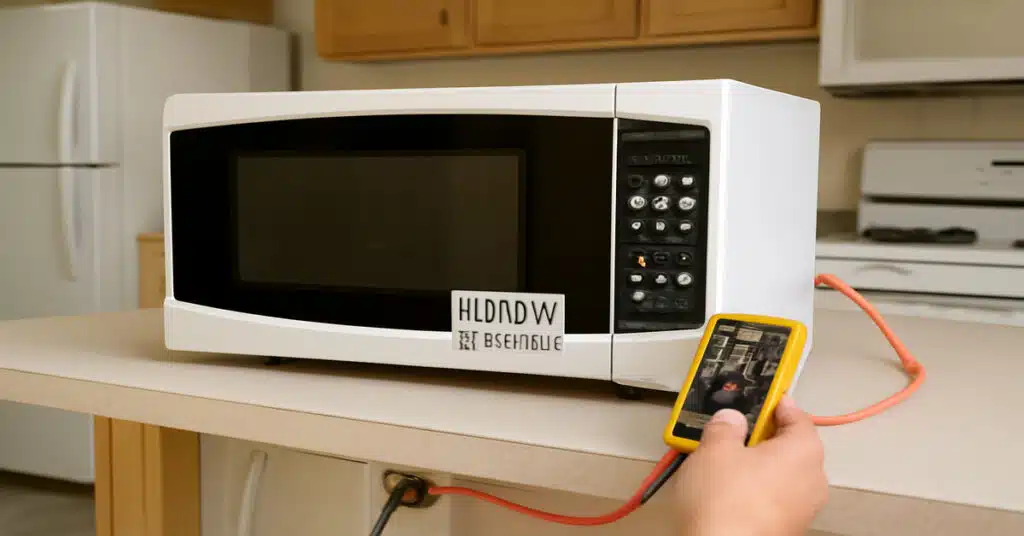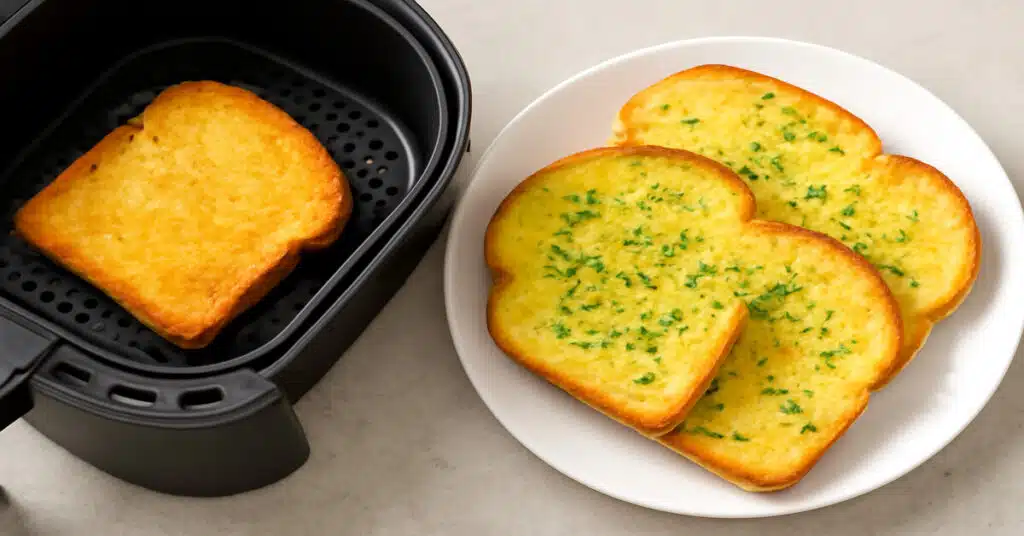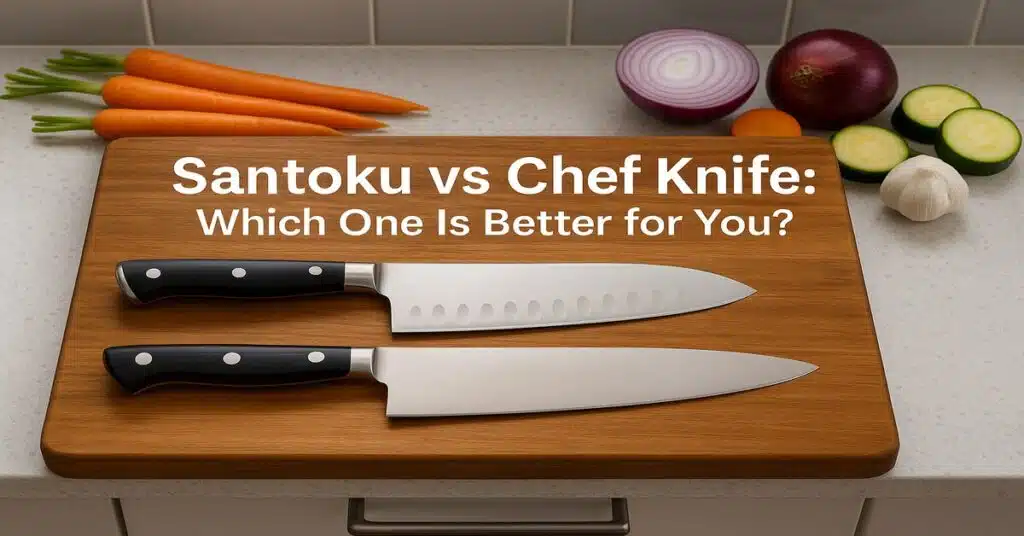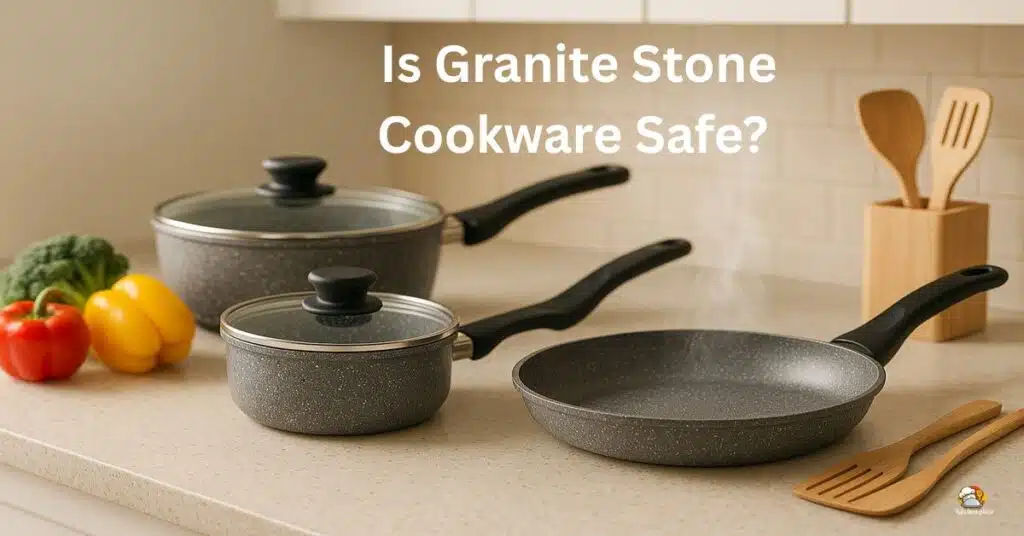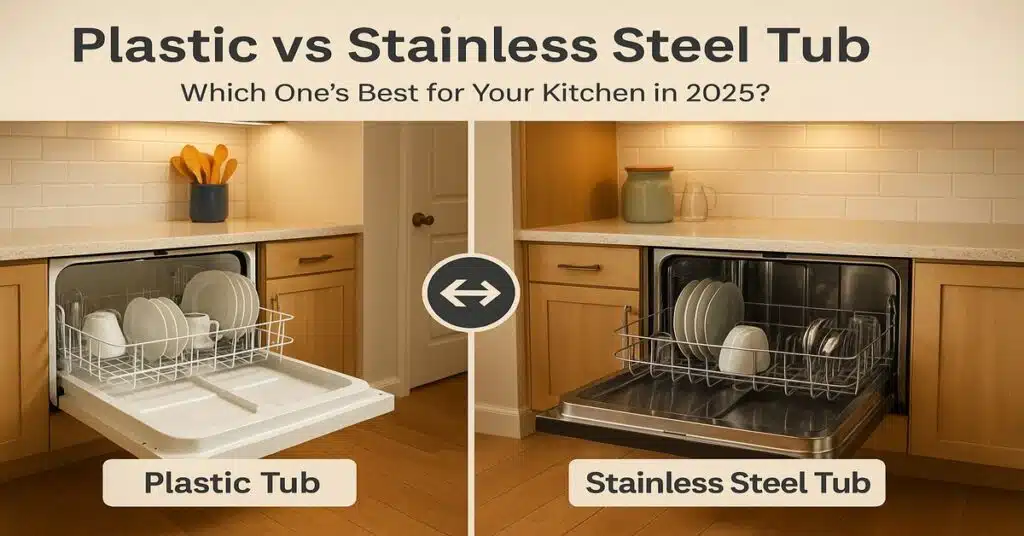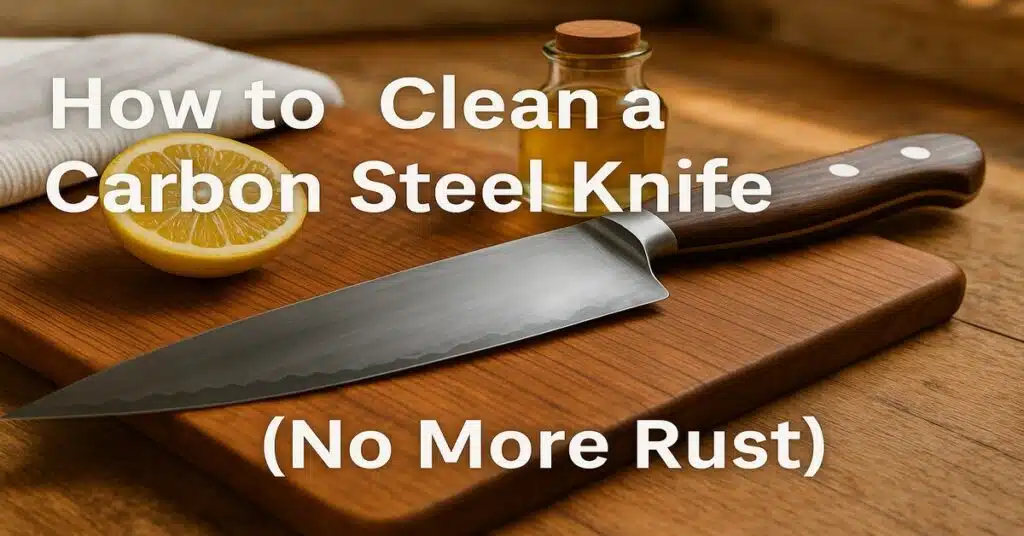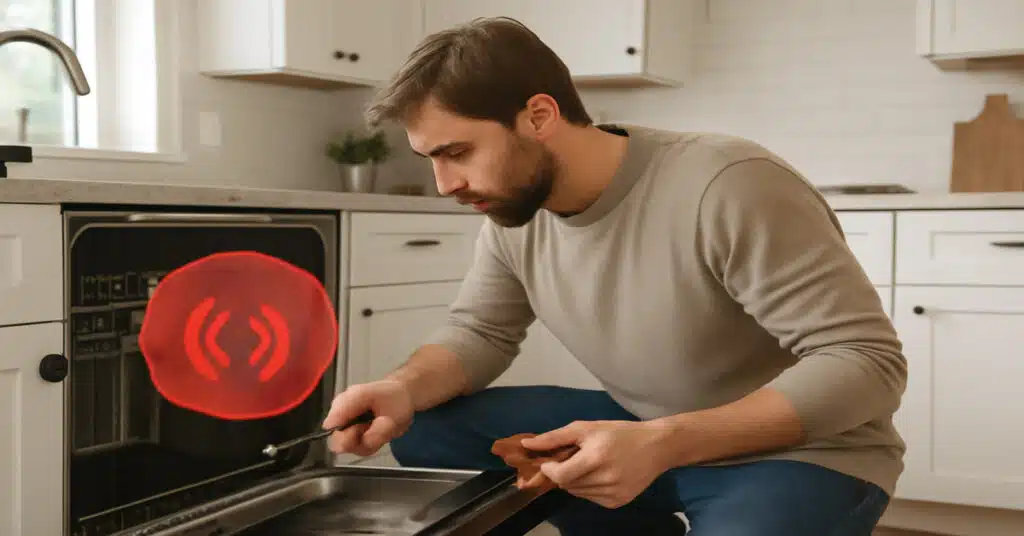Yes, stainless-steel cookware is one of the safest choices for daily cooking. Food-grade alloys such as 304 (18/8) and 316 (18/10) create a thin chromium-oxide layer that stops harmful metals from touching your food. Even under heat or acid, studies show nickel and chromium levels stay well below FDA and WHO safety limits.
Why People Trust Stainless-Steel Pans
For many home cooks, stainless-steel pans stand for strength, purity, and long life. They shine for years, resist rust, and keep food tasty without any chemical coating.
Still, many people ask, Is stainless steel really safe?
To find the truth, let’s look inside this trusted material.
How Stainless Steel Works
Stainless steel is an iron-based metal mixed with small amounts of chromium and nickel. When air touches it, these elements form a thin, invisible film called the chromium-oxide layer.
This natural coating keeps rust away and stops metals from moving into your food. That is why good-quality stainless steel is called non-reactive — it doesn’t react with what you cook.
If your pan is not deeply scratched or heated above 600 °F (315 °C), the layer stays strong. It protects your food and keeps the pan shiny for years.
Approved and Tested Safety
Both 304 and 316 stainless steel are tested and approved by:
- The U.S. FDA (Food and Drug Administration)
- The European Food Safety Authority (EFSA)
- California Prop 65 regulations
These grades are safe for everyday use in homes and restaurants worldwide.
Fun fact: Stainless” means resists stains, not shiny metal — the name comes from its ability to fight rust and spots.
Ready to upgrade?
Explore our expert-tested guide on Best Stainless Steel Cookware Sets to find which 304 and 316-grade pans offer the best mix of safety, durability, and performance.
Now that we know stainless steel cookware is trusted for safety, let’s see what it’s actually made of — because the secret lies in the metal itself.
What Is Stainless Steel Cookware Made Of?
Stainless steel cookware is made from a mix of iron, chromium, and nickel. These metals make it strong, shiny, and rust-free.
Chromium (around 18%) creates a thin shield that stops rust, and nickel (8–10%) helps the metal stay smooth when cooking with acids like tomato or lemon.
Good-quality pans use multi-ply layers — aluminum or copper inside stainless steel — for even heat and fewer hot spots.
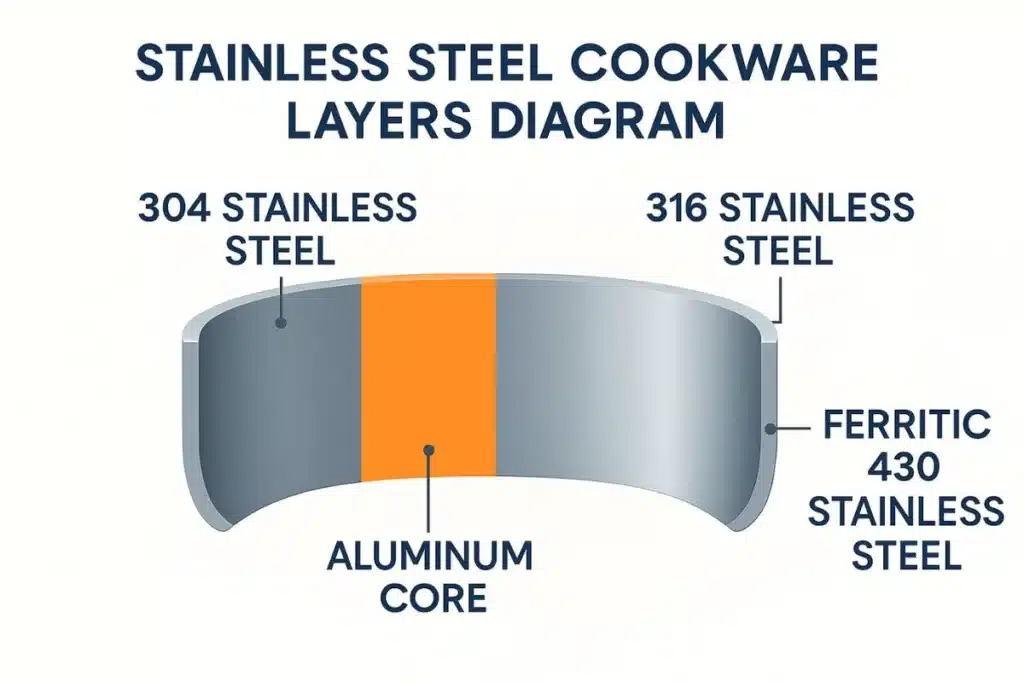
Common Grades of Stainless Steel
| Grade | Composition | Food Safety |
| 18/10 (304) | 18% chromium, 10% nickel | Very common, safe for all foods, resists rust and stains |
| 316 | 16% chromium, 10% nickel, 2% molybdenum | Marine-grade; best for salty or acidic foods |
| 430 | 17% chromium, 0% nickel | Magnetic, low-cost, less resistant to salt corrosion |
Tip: The numbers like 18/10 or 18/8 tell how much chromium and nickel the steel has. More chromium means stronger protection. More nickel means smoother and shinier metal.
Why These Metals Matter
- Chromium keeps the steel “stainless.”
It reacts with air to form a natural, invisible layer that prevents rust. - Nickel adds shine and strength.
It helps protect your pan when cooking tomato or lemon dishes. - Molybdenum (in 316 steel) adds extra resistance to salt and moisture.
- Aluminum or copper cores inside the layers spread heat evenly so your food cooks better and faster.
Real-Life Examples
Top cookware brands such as All-Clad, Cuisinart, and Demeyere use these metal grades in their best-selling pans.
Their 3-ply or 5-ply designs blend science and art — offering fast heating, lasting shine, and surfaces that do not react with food flavors.
Expert Safety Note
According to the U.S. FDA food-contact standards (21 CFR 177.2600),stainless steel grades 304 and 316 are safe for long-term cooking, even with acidic or salty foods.
They are also approved by California Prop 65 and the European Food Safety Authority (EFSA) for daily kitchen use.
Knowing the ingredients is one thing — but what happens when your pan meets high heat? That’s where stainless steel’s real strength shows.
Is Stainless Steel Cookware Safe When Heated?
What Happens at High Heat
When you heat a stainless-steel pan, science starts working for you. The chromium inside the metal reacts with oxygen in the air to create a thin oxide layer. This invisible shield protects your food from touching the metal beneath.
The layer stays strong and stable up to 500°F (260°C).
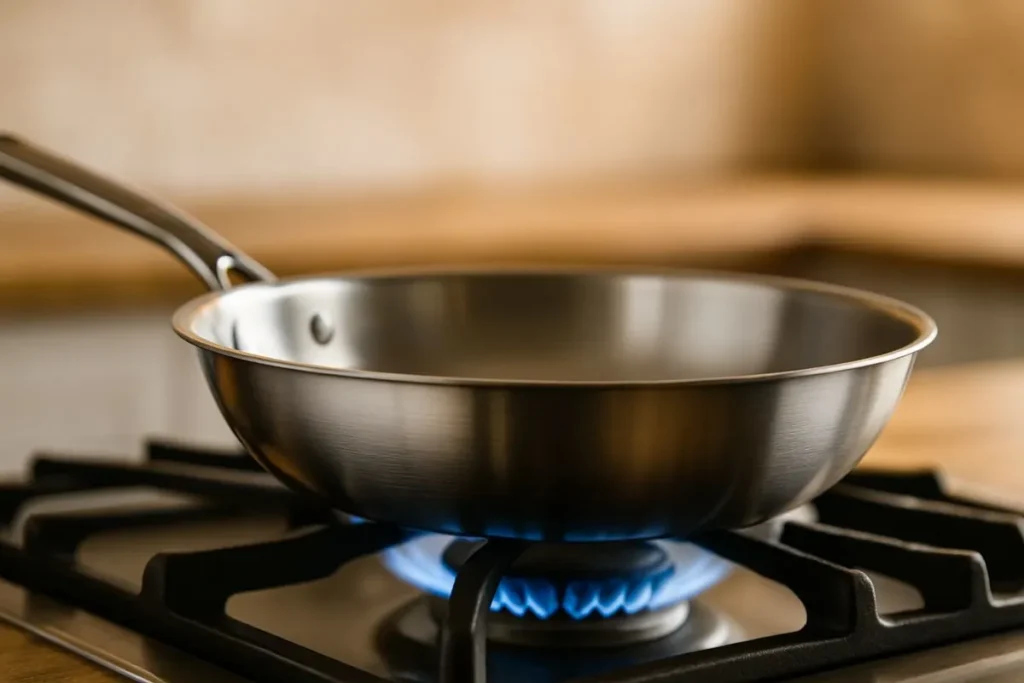
At that temperature, stainless steel stays non-reactive. It does not release harmful metals or fumes.
That’s why 18/10 stainless-steel pans are great for searing meat or browning vegetables. They can handle high heat without warping, changing color, or affecting taste.
Fact: According to a 2022 PubMed study, stainless steel remains stable up to 500°F (260°C) before any measurable nickel release begins.
When Does It Become Unsafe?
Trouble starts when a pan is overheated while empty. If it reaches above 600°F (315°C), the surface may show rainbow or blue tints.
Don’t worry — that color is oxidation, not poison.
But repeated overheating can slowly weaken the oxide layer and cause pitting (tiny holes).
Thermal shock is another risk.
Pouring cold water on a very hot pan can make it warp or crack. It won’t make your food unsafe, but it will reduce the pan’s lifespan.
In short:
- Avoid heating an empty pan until it smokes.
- Let it cool naturally before rinsing with water.
- Always preheat gently for 1–2 minutes on medium heat.
Practical Safety Tips
✅ Preheat Smartly: Heat the pan for 2 minutes on medium flame, not high.
✅ Avoid Overheating: Don’t let the pan smoke or turn red.
✅ Cool Slowly: Never put a hot pan under cold water.
✅ Clean Safely: Use a baking-soda paste to clean brown spots; avoid steel wool.
If your pan turns brown, that’s only oxidation — clean it, don’t replace it. Learn how to remove heat stains and restore the protective oxide layer → How to Clean Stainless Steel Cookware.
Heat isn’t the only test your pan faces — acids like tomato or vinegar can challenge it too. Let’s find out how stainless steel reacts with acidic foods.
Is Stainless Steel Safe for Acidic Foods?
Yes — stainless-steel cookware is safe for acidic foods like tomato or vinegar dishes. Cooking such meals may release a very small amount of nickel or chromium, but the level is far below the FDA’s safe daily limit.
Using high-quality 18/10 or 316 stainless steel pans keeps the amount even lower and completely harmless for daily cooking.
Food Reaction Chart
| Food Type | Reaction Risk | Notes |
| Neutral (rice, eggs) | Very low | Perfect for everyday use |
| Acidic (tomato, vinegar) | Mild | Tiny nickel release possible |
| Salty or brined foods | Low | Rinse after cooking to prevent stains |
Tip: The more acidic the food, the higher the chance of minor metal release — but still under safe limits.
Why Acidic Foods Are Safe in Stainless Steel
Acidic foods, such as tomato sauce or lemon juice, react slightly with metals. However, stainless steel’s chromium-oxide layer stops most of this reaction. This layer works like a shield, blocking metals from moving into food.
A 2013 study in Food Chemistry found that boiling tomato purée for 10 hours in 304-grade steel increased nickel by less than 1% of the safe daily limit. So, unless you simmer sauce all day in a brand-new pot, your food is perfectly safe.
Cooking & Care Tips
✅ Use seasoned cookware: The older the pan, the stronger the protective layer.
✅ Avoid long acidic cooking: Don’t simmer tomato sauce for more than 3 hours in one go.
✅ Clean gently: Rinse after use; dry the pan to stop salt spots.
✅ Choose better grades: Pick 316 if you cook many acidic dishes.
Note: Acid may slightly dull the shine, but it doesn’t affect food safety.
You might wonder — if acids interact with the surface, does that mean metals like nickel or chromium leach into food? Science has a clear answer.
Does Stainless Steel Leach Nickel or Chromium?
No — stainless steel doesn’t leach harmful levels of nickel or chromium while cooking. Research shows the metal stays stable even with acidic or salty foods. A new pan may release trace amounts, but they’re far below FDA and WHO limits for safe daily intake.
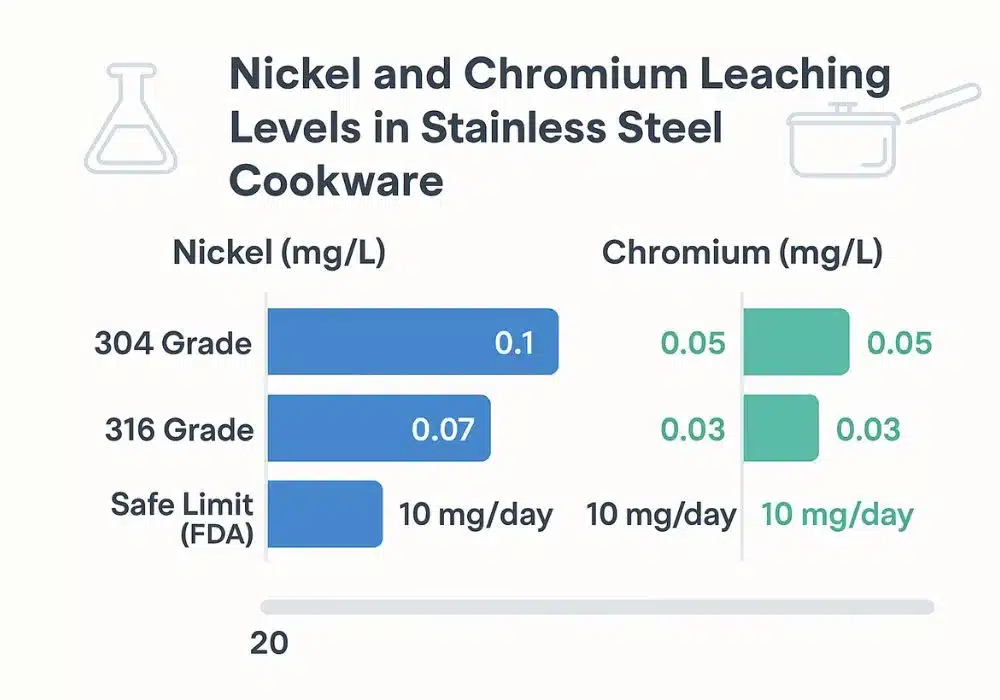
What Research Shows
Modern studies find stainless steel is mostly non-reactive. A 2019 PubMed study measured nickel release between 0.03 and 0.14 mg per liter — less than 1 percent of safe intake. The FDA (2022) confirmed that 304 and 316 grades pose no measurable health risk under normal cooking.
Fact Box
• Typical leaching ≈ 0.1 mg/L (acidic test)
• Safe daily tolerance = 100 × higher
In other words, you’d need to cook tomato sauce daily for hours to reach even 1 percent of the limit.
Why Leaching Happens (and Why It’s Minimal)
When food meets the metal, a small ion exchange begins —but the chromium-oxide film rebuilds instantly, blocking further transfer. That self-healing layer keeps your cookware safe and shiny for decades.
Nickel-Free & Low-Nickel Options
If you’re sensitive to nickel, choose 18/0 or 21/0 cookware. Brands like 360 Cookware and Vollrath make durable nickel-free sets.
| Grade | Nickel % | Notes |
| 18/10 (304) | 10 | Most common; safe for all |
| 316 | 10 + molybdenum | Best for acidic foods |
| 18/0 or 21/0 | 0–1 | Nickel-free; allergy-friendly |
Tip: For severe nickel allergy, cook tomato or vinegar dishes in ceramic or glass occasionally.
Even if stainless steel is strong, no pan is perfect forever. Scratches happen — but are they dangerous? Let’s see what experts say.
Is Scratched Stainless Steel Safe?
Yes — light scratches are harmless.
The protective chromium-oxide film on stainless steel can repair itself within hours. However, deep scratches or pitting can expose the base metal and increase the chance of minor leaching — especially when cooking acidic foods like tomato or lemon.
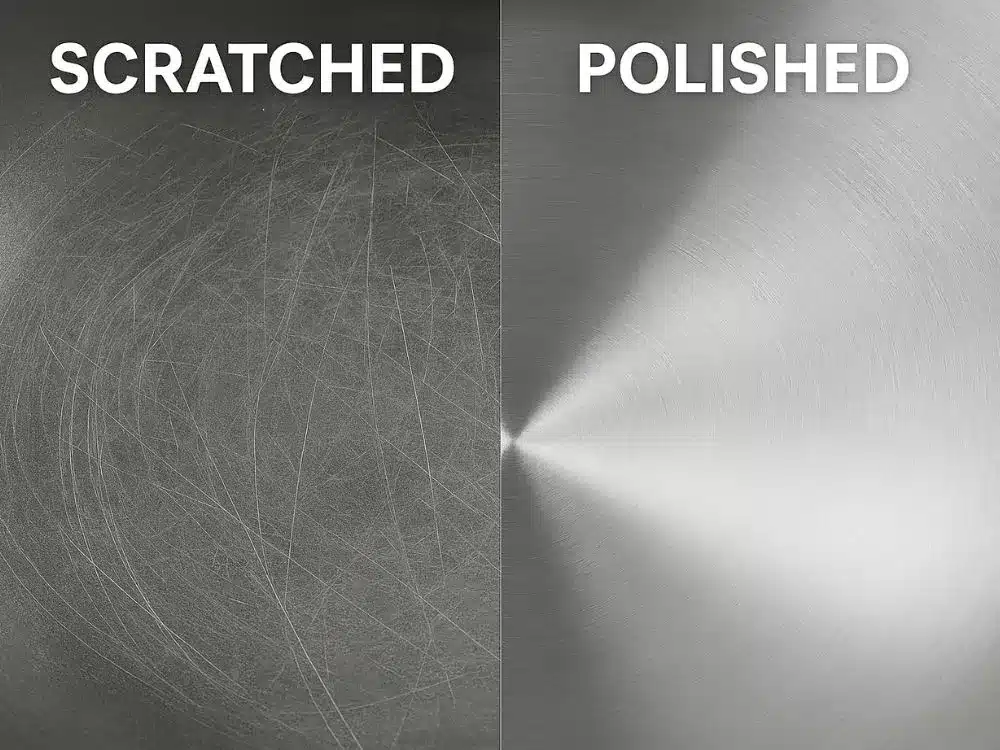
If your pan looks dull or rough, it might be time to upgrade to a certified 304- or 316-grade stainless steel cookware that lasts longer and resists corrosion.
That glossy finish you see on your cookware exists because of a chromium-oxide layer — a microscopic barrier that keeps your food safe. When you scrub too hard or use steel wool, you strip that layer off. The good news is that oxygen in the air naturally rebuilds it.
If you notice dull patches or rainbow stains, don’t panic — it’s oxidation, not toxicity. You can easily fix it with a gentle baking soda paste (see our guide on How to Fix Discolored Stainless Steel Pans).
Practical Tip Box
✅ Avoid harsh scrubbers — use a soft sponge.
✅ Rinse immediately after cooking acidic or salty foods.
✅ Dry thoroughly to prevent pitting corrosion.
✅ For older cookware, re-season it once a month.
If your pan has visible rust spots or pitting, switch to a trusted brand known for build quality — like those in our Best Stainless Steel Cookware Brands list.
Surface safety is one part of the story. The other part is regulation — what makes a metal truly “food-grade”? Let’s break that down.
What Is Food-Grade Stainless Steel?
Food-grade stainless steel refers to alloys — typically 304 or 316 — that are approved by the FDA and ISO for direct contact with food. These steels are non-reactive, corrosion-resistant, and remain safe even under high heat or acidic conditions.
The term food-grade means that a metal meets strict FDA and ISO 8442-2 standards for food safety.
Grade 304 stainless steel is ideal for everyday cooking, while 316, often called surgical steel, provides extra protection against salt and acid.
Under California’s Prop 65, manufacturers must test cookware for lead, cadmium, and other heavy metals — standards already met by trusted brands such as All-Clad, Demeyere, and Cuisinart.
If a product is labeled only as “stainless steel” without grade information, avoid it, since cheaper alloys may corrode or leach metals under stress.
In short, food-grade stainless steel is safe, durable, and non-reactive, making it the best choice for cooking, serving, and food storage.
While food-grade steel is safe for almost everyone, there’s one group that should take extra care — people sensitive to nickel.
Who Should Be Careful with Stainless Steel?
Most people can safely use stainless-steel cookware.
However, if you have a nickel allergy or sensitive skin, avoid long cooking sessions with high-nickel alloys like 18/10 or 304. Choose nickel-free options such as 18/0 or 21/0, which are safer for people with dermatitis or allergic reactions.
Stainless steel is safe for almost everyone, but people with nickel sensitivity may experience mild skin or stomach irritation after long use. According to the U.S. National Library of Medicine, around 10% of adults have some level of nickel sensitivity.
Cooking tomato or lemon-based dishes in 18/10 cookware can release tiny amounts of nickel, which might trigger a reaction in sensitive users.
According to the California Prop 65 list all cookware sold in the U.S. must meet strict testing standards to ensure non-toxic metal levels.
For allergy-friendly choices, go for nickel-free (18/0) or titanium-reinforced cookware made by trusted brands like 360 Cookware or Vollrath. You can also use cast iron or ceramic cookware, which are completely non-reactive and ideal for sensitive users.
In short, if you’re nickel-sensitive, switch to nickel-free or ceramic cookware — it’s safer, durable, and helps you cook without worry.
Whether you have allergies or not, the best safety always comes from proper use. Here’s how to handle stainless steel the right way.
How to Use Stainless Steel Cookware Safely
Using stainless steel cookware safely isn’t hard — you just need a few simple habits to keep it durable, shiny, and non-toxic. Follow these easy steps to prevent metal leaching, scratches, or discoloration while cooking every day.
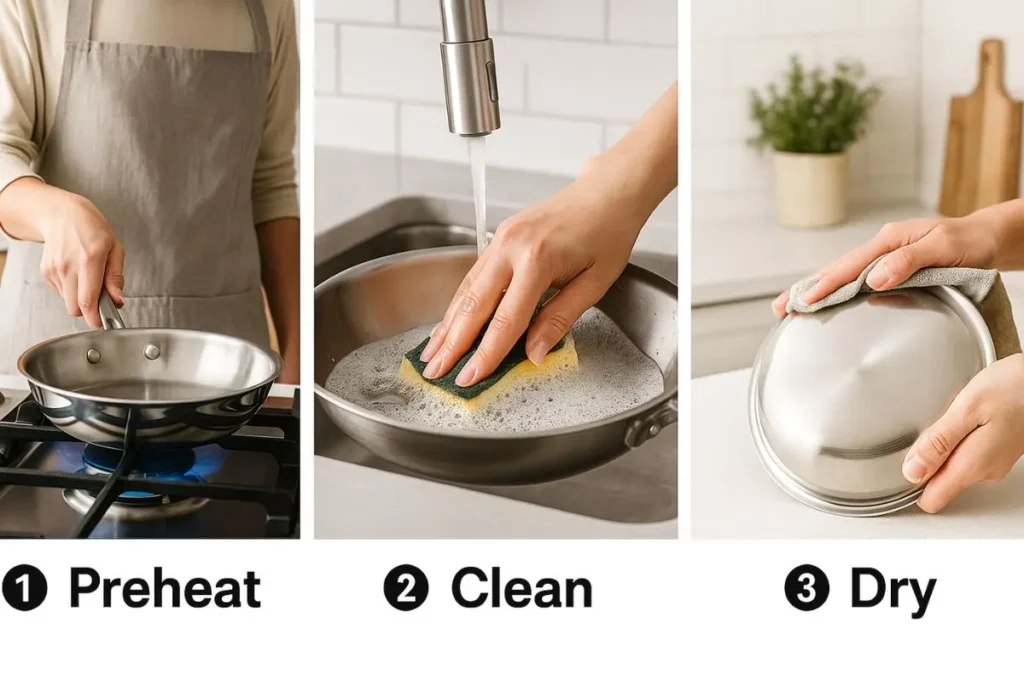
Step-by-Step Guide
1️⃣ Preheat your pan for 1–2 minutes on medium heat.
Preheating helps the steel expand evenly and reduces food sticking.
2️⃣ Never heat an empty pan until it smokes.
Overheating can discolor the surface and weaken the protective oxide layer.
3️⃣ Use wooden or silicone utensils.
They prevent scratches that can expose raw metal and shorten your pan’s lifespan.
4️⃣ Avoid storing acidic food in the pan.
Tomato or vinegar-based dishes can react with the surface if left for long periods.
5️⃣ Clean with warm water and a baking soda paste.
Skip harsh scrubbers or steel wool — they damage the non-reactive surface layer.
6️⃣ Dry your cookware immediately after washing.
This stops pitting and keeps your pan rust-free for years to come.
Pro Tip
If your pan ever turns brown or rainbow-colored, don’t worry — it’s oxidation, not damage. You can easily restore the shine (see our guide on How to Clean Stainless Steel Cookware).
Now that you know how to use it safely, let’s see how stainless steel compares to other cookware materials in everyday cooking.
Stainless Steel vs Other Cookware
Every cookware material has its own strengths and weaknesses.
This quick comparison shows how stainless steel stacks up against nonstick, cast iron, ceramic, and hard-anodized aluminum cookware in terms of toxicity, reactivity, heat tolerance, and maintenance. It’s designed to help you choose the safest and most practical cookware for everyday cooking.
Cookware Comparison Table
| Cookware Type | Non-Toxic | Reactivity | Maintenance | Heat Tolerance |
| Stainless Steel (304/316) | ✅ | Low | Easy | 500 °F + |
| Nonstick (Teflon/PTFE) | ⚠️ | Medium | Moderate | 400 °F |
| Cast Iron | ✅ | Medium | High | 600 °F + |
| Ceramic | ✅ | Very Low | Fragile | 450 °F |
| Hard-Anodized Aluminum | ✅ | Low | Moderate | 500 °F |
Key Takeaways
Stainless steel offers the best balance of durability, safety, and performance. Unlike nonstick cookware, it emits no fumes and can handle high heat without damage. Compared to cast iron, it needs less upkeep and doesn’t rust or absorb flavors. While ceramic cookware is non-reactive and toxin-free, it’s more fragile under thermal shock.
Hard-anodized aluminum is heat-efficient but may lose its coating over time. For long-term reliability, 18/10 or 316-grade stainless steel remains the most consistent “safe choice”—non-toxic, scratch-resistant, and easy to maintain.
Each cookware has pros and cons, but when it comes to safety and durability, stainless steel often leads the pack. Let’s wrap up with the final verdict.
Final Verdict — Is Stainless Steel Cookware Safe?
Yes — stainless-steel cookware made from 18/10 (304) or 316 food-grade steel is completely safe for everyday cooking.
It doesn’t release harmful metals and resists corrosion even under high heat or acidic foods. That’s why chefs and home cooks worldwide trust stainless steel as one of the safest, most durable cookware materials.
For almost every home cook, high-quality stainless steel is fully non-toxic and long-lasting. Grades such as 18/10 (304) and 316 surgical steel form a natural chromium-oxide shield that prevents nickel or chromium transfer — even when cooking acidic or salty dishes. Avoid cheap or unbranded cookware that lacks grade markings or shows pitting, since these may corrode over time.
Brands like All-Clad, Demeyere, Made In, Cuisinart, and 360 Cookware meet strict FDA and California Prop 65 standards for food safety. With basic care and gentle cleaning, a stainless-steel pan can last decades without losing shine, safety, or flavor.
Cook with Confidence
If you’re upgrading your kitchen, explore our in-depth guides: Learn about performance and durability in our Best Stainless Steel Cookware Sets and discover toxin-free options in our Safest Stainless Steel Brands. Cook confidently knowing your cookware is built for health and longevity.
Still curious about specific situations — like cooking acidic foods or handling scratches? Let’s answer the most common stainless steel safety questions.
Frequently Asked Questions About Stainless Steel Cookware Safety
Below are the most frequently asked questions about stainless steel cookware safety — collected from Google, FDA reports, and real kitchen experiences. Each answer is written to be clear, evidence-based, and easy to understand.
These FAQs summarize everything from heat stability and nickel leaching to material comparison and food-grade standards, helping you make confident and safe cooking choices every day. All responses follow verified research, including FDA food-contact regulations (21 CFR 177.2600) and the Food Metals Study (PubMed, 2022).
Is stainless steel cookware safe?
Yes — stainless steel cookware made from 18/10 (304) or 316 food-grade steel is completely safe for daily cooking.
According to the U.S. FDA, these grades are approved for all food contact surfaces.
Is stainless steel toxic when heated?
No — stainless steel remains stable and non-toxic up to around 500°F (260°C). Studies published in Food Metals Journal (2022) confirm no harmful leaching occurs under normal cooking.
Is stainless steel cookware safer than nonstick?
Yes — stainless steel is safer than nonstick because it contains no PTFE or PFOA coatings that may degrade with heat.It also lasts longer and doesn’t emit fumes. Explore a full breakdown in our comparison: [Stainless Steel vs Nonstick Cookware].
Is 18/10 stainless steel safe for cooking?
Yes — 18/10 stainless steel (also known as 304) is FDA-approved for cookware and cutlery. It contains 18% chromium and 10% nickel, giving it superior corrosion resistance.
Is stainless steel safer than ceramic cookware?
Both are safe, but stainless steel is more durable and handles higher heat. Ceramic is fully non-reactive but prone to cracking or chipping. See the key differences in [Stainless Steel vs Ceramic Cookware] for a complete comparison.
What are the negatives of stainless steel cookware?
The main downside is food may stick if the pan isn’t preheated properly. It’s also heavier and needs regular polishing. However, its safety and lifespan outweigh these drawbacks.
What foods should not be cooked in stainless steel?
Avoid simmering acidic or salty foods (like tomato or vinegar) for too long, especially in new pans. Acid can cause mild pitting over time.
Is scratched stainless steel safe to use?
Light scratches are harmless — the chromium-oxide layer naturally repairs itself. But deep pitting can lead to corrosion or mild leaching. Find easy fixes in our cleaning guide: [How to Fix Discolored Stainless Steel Pans].
How can I prevent food from sticking to stainless steel?
Preheat your pan for 1–2 minutes, add oil, and cook on medium heat. This helps form a temporary nonstick barrier.
How to know if stainless steel is food safe?
Check for markings such as “304,” “316,” or “18/10” on the cookware base — all are FDA-approved grades. Avoid unlabeled or low-grade steel. Find a list of verified brands in [Safest Stainless Steel Cookware Brands].
Author Bio :
Written by MD Soazim, a stainless steel cookware expert and product reviewer at KitchenPluse.com. He tests and reviews the best stainless steel cookware sets in the United States, focusing on safety, durability, and FDA-approved food-grade materials to help home cooks choose non-toxic, long-lasting kitchen essentials.

